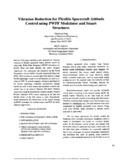Zero-propellant maneuver guidance
| dc.contributor.author | Bedrossian, Nazareth S. | |
| dc.contributor.author | Bhatt, Sagar | |
| dc.contributor.author | Kang, Wei | |
| dc.contributor.author | Ross, Michael I. | |
| dc.date | 2009 | |
| dc.date.accessioned | 2018-02-13T21:31:51Z | |
| dc.date.available | 2018-02-13T21:31:51Z | |
| dc.date.issued | 2009 | |
| dc.identifier.citation | Bedrossian, N., Bhatt, S., Kang, W. & Ross, I.M. 2009, "Zero-propellant maneuver guidance", IEEE Control Systems Magazine, vol. 29, no. 5, pp. 53-73. | en_US |
| dc.identifier.uri | https://hdl.handle.net/10945/56999 | |
| dc.description.abstract | To maintain its orbit and control its attitude, the International Space Station (ISS) is equipped with thrusters as well as four control moment gyroscopes (CMGs). The CMGs can be used only for attitude control, while the thrusters can be used for either attitude control or orbit corrections. For attitude control, thrusters can complete reorientations much more rapidly than the CMGs since the torque capability of the thrusters is at least an order of magnitude larger than the torque capability of the CMGs. However, using thrusters has signifi cant disadvantages, such as consumption of propellant, solar array contamination, and stressing of the ISS structure. CMGs can avoid these disadvantages as long as they operate within their angular momentum capacity because they are powered by electricity generated by the ISS solar arrays. If the CMG momentum becomes saturated, that is, the total angular momentum of the CMGs reaches its maximum value, the control authority of the CMGs is considered lost. For further information about CMGs and saturation, see “CMGs, Momentum Saturation, and Robotics Analogy.” Even at a slow rate of rotation, large-angle ISS maneuvers performed with CMGs can result in momentum saturation because the CMGs must compensate for the environmental disturbance torques on the ISS along the fl ight-software-generated attitude trajectory. As a result, until 2006 all large-angle ISS rotations were performed using thrusters. | |
| dc.description.sponsorship | NASA Glenn Research Center | |
| dc.description.sponsorship | The Charles Stark Draper Laboratory, Inc. | |
| dc.format.extent | 22 p. | |
| dc.language.iso | en_US | |
| dc.publisher | IEEE | |
| dc.rights | This publication is a work of the U.S. Government as defined in Title 17, United States Code, Section 101. Copyright protection is not available for this work in the United States. | en_US |
| dc.title | Zero-propellant maneuver guidance | en_US |
| dc.type | Article | en_US |
| dc.contributor.corporate | Naval Postgraduate School (U.S.) | |
| dc.contributor.department | Applied Mathematics | en_US |
| dc.description.funder | NASA contract NNJ06HC37C |





